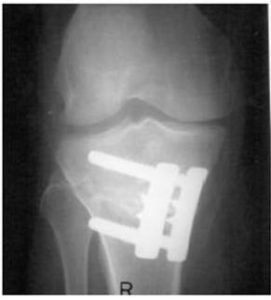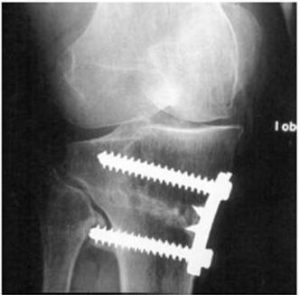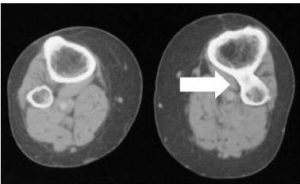1. Aglietti, P., Buzzi, R., Vena, L. M., Baldini, A. & Mondaini, A. (2003). “High Tibial Valgus Osteotomy for Medial Gonarthrosis: A 10- to 21-Year Study,” The Journal of Knee Surgery. 16:21-6
Publisher – Google Scholar
2. Esenkaya, I. & Elmali, N. (2006). “Proximal Tibia Medial Open-Wedge Osteotomy Using Plates with Wedges: Early Results in 58 Cases,” Knee Surgery, Sports Traumatology, Arthroscopy. 14:955-61.
Publisher – Google Scholar
3. Esenkaya, I. (2005). “Fixation of Proximal Tibia Medial Opening Wedge Osteotomy Using Plates with Wedges,” Acta Orthopaedica et Traumatologica Turcica. 39:211-23
Publisher – Google Scholar
4. Flierl, S., Sabo, D., Hornig, K. & Perlick, L. (1996). “Open Wedge High Tibial Osteotomy Using Fractioned Drill Osteotomy: Surgical Modification that Lowers the Complication Rate,” Knee Surgery, Sports Traumatology, Arthroscopy4:149-153.
Publisher – Google Scholar
5. Insall, J. N., Joseph, D. M. & Msika, C. (1984). “High Tibial Osteotomy for Varus Gonarthrosis. A Long-Term Follow-Up Study,” The Journal of Bone & Joint Surgery. 66:1040-8
Publisher – Google Scholar
6. Ivey, M. & Cantrell, J. S. (1985). “Lateral Tibial Plateau Fracture as a Postoperative Complication of High Tibial Osteotomy,” Orthopedics 8:1009-1013.
Publisher – Google Scholar
7. Magyar, G., Toksvig-Larsen, S. & Lindstrand, A. (1998). “Open Wedge Tibial Osteotomy by Callus Distraction in Gonarthrosis,” Acta Orthopaedica Scand 69:147-151.
Publisher – Google Scholar
8. Miller, B. S., Downie, B., McDonough, E. B., Wojtys, E. M. (2009). “Complications after Medial Opening Wedge High Tibial Osteotomy,” Arthroscopy. 25:639-46
Publisher – Google Scholar
9. Naudie, D., Bourne, R. B., Rorabeck, C. H. & Bourne, T. J. (1999). “Survivorship of the High Tibial Valgus Osteotomy. A 10- to -22-Year Followup Study,” Clinical Orthopaedics & Related Research. 367:18-27
Publisher – Google Scholar
10. Spahn, G. (2003). “Complications in High Tibial (Medial Opening Wedge) Osteotomy,” Archives of Orthopaedic and Trauma Surgery 124:649-653.
Publisher – Google Scholar
11. Tjörnstrand, B., Hagstedt, B. & Persson, B. M. (1978). “Results of Surgical Treatment for Non-Union after High Tibial Osteotomy in Osteoarthritis of the Knee,” The Journal of Bone & Joint Surgery. American Volume. 60:973-7
Publisher – Google Scholar
12. Wildner, M., Peters, A., Hellich, J. & Reichlt, A. (1992). “Complications of High Tibial Osteotomy and Internal Fixation with Staples,” Archives of Orthopaedic and Trauma Surgery 111:210-212.
Publisher – Google Scholar
13. Nishimura, T., Nii, E., Urawa, M., Nishiyama, M., Taki, S. & Uchida, A. (2008). “Proximal Tibiofibular Synostosis with 49,XXXXY Syndrome, a Rare Congenital Bone Anomaly,” Journal of Orthopaedic Science. 13:390-5
Publisher – Google Scholar
14. Lenin Babu, V., Shenbaga, N., Komarasamy, B. & Paul, A. (2006). “Proximal Tibiofibular Synostosis as a Source of Ankle Pain: A Case Report,” The Iowa Orthopaedic Journal. 26:127-9.
Publisher – Google Scholar
15. Bozkurt, M., Doğan, M. & Turanli, S. (2004). “Osteochondroma Leading to Proximal Tibiofibular Synostosis as a Cause of Persistent Ankle Pain and Lateral Knee Pain: A Case Report,” Knee Surgery, Sports Traumatology, Arthroscopy. 12:152-4.
Publisher – Google Scholar
16. Takai, S., Yoshino, N. & Hirasawa, Y. (1999). “Unusual Proximal Tibiofibular Synostosis,” International Orthopaedics. 23:363-5
Publisher – Google Scholar
17. Harborne, D. J. & Lennox, W. M. (1989). “Distal Tibiofibular Synostosis Due to Direct Trauma,” Injury. 20:377-8
Publisher – Google Scholar
18. O’Dwyer, K. J. (1991). “Proximal Tibio-Fibular Synostosis: A Rare Congenital Anomaly,” Acta Orthopasdica Belgica57:204—8
Publisher – Google Scholar
19. Solomon, L. (1961). “Bone Growth in Diaphysial Aclasis,” The Journal of Bone & Joint Surgery. British Volume43:700—16.
Publisher – Google Scholar
20. Wong, K. & Weiner, D. S. (1978). “Proximal Tibiofibular Synostosis,” Clinical Orthopaedics & Related Research 135:45—7
Publisher – Google Scholar
21. Albers, G. H., de Kort, A. F., Middendorf, P. R. & van Dijk, C. N. (1996). “Distal Tibiofibular Synostosis after Ankle Fracture. A 14-Year Follow-up Study,” The Journal of Bone & Joint Surgery. British Volume. 78:250-2
Publisher – Google Scholar
22. Hou, Z.- H., Zhou, J.- H., Ye, H., Shi, J.- G., Zheng, L.- B., Yao, J. & Ni, Z.- M. (2009). “Influence of Distal Tibiofibular Synostosis on Ankle Function,” Chinese Journal of Traumatology. 12:104-6.
Publisher – Google Scholar
23. Kaye, R. A. (1989). “Stabilization of Ankle Syndesmosis Injuries with a Syndesmosis Screw,” Foot & Ankle International. 9:290-3.
Publisher – Google Scholar







